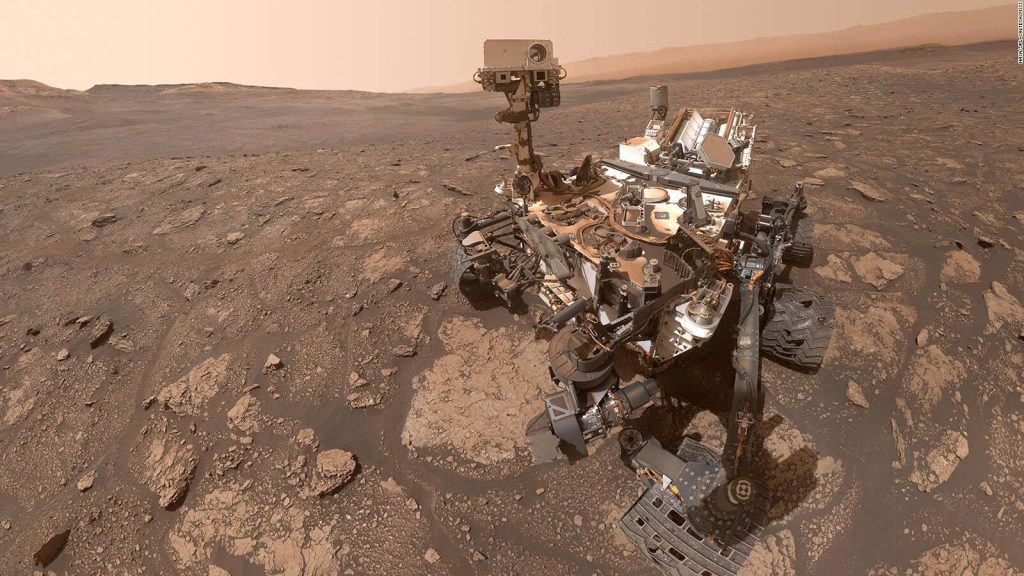(CNN) – In the search for extraterrestrial life, NASA’s Curiosity spacecraft has been on a nearly decade-long mission to determine if Mars is habitable by living creatures.
A new analysis of sediment samples collected by the rover has revealed the presence of carbon, and the possibility of ancient life on the Red Planet is just one possible explanation for why it is.
Carbon is the basis of all life on Earth, and the carbon cycle is the natural process of recycling carbon atoms. On our planet, carbon atoms go through a cycle as they travel from the atmosphere to Earth and back into the atmosphere. Most of the carbon is found in rocks and sediments, and the rest is in the ocean, atmosphere, and living things, according to the National Oceanic and Atmospheric Administration (NOAA).
Therefore, carbon atoms – with their recycling cycle – are a tracer of biological activity on Earth. So they could be used to help researchers determine if life existed on ancient Mars.
When these atoms are measured inside another material, such as a Martian sediment, they can shed light on the planet’s carbon cycle, no matter when it occurred.
Knowing more about the origin of this newly discovered Martian carbon could also reveal the process of the carbon cycle on Mars.
A detailed study of these findings was published in the journal Monday Proceedings of the National Academy of Sciences.
Secrets in the sediment
Curiosity landed in Gale Crater on Mars in August 2012. This 96-mile (154.5 km) crater, named after Australian astronomer Walter F. Gale, was likely formed by a meteorite impact between 3,500 and 3.8 billion years ago. The Great Bore likely once housed a lake, and now includes a mountain called Mount Sharp. The crater also includes layers of exposed old rock.
To take a closer look, the probe was drilled to collect sediment samples throughout the crater between August 2012 and July 2021. Curiosity then heated these dust samples to about 1,562 degrees Fahrenheit (850 degrees Celsius) to separate the elements. This caused the samples to release methane, which was then analyzed by another instrument in the rover’s arsenal to show the presence of stable isotopes of carbon, or carbon atoms.
Some samples were low carbon, while others were enriched. Carbon has two stable isotopes, measured as carbon 12 or carbon 13.
Christopher H. said: release.
“These samples were the result of biological activity when methane was consumed by ancient microbial mats, but we can’t necessarily say that on Mars because it is a planet that may have formed with different materials and processes than those on Earth.”
In lakes on Earth, microbes like to grow in large colonies that essentially form mats just below the surface of the water.
3 potential sources of carbon
Different measurements of carbon atoms can indicate three very different things about ancient Mars. The origin of carbon may be due to cosmic dust, ultraviolet decomposition of carbon dioxide, or ultraviolet decomposition of biologically produced methane.
According to the researchers, “all three scenarios are unconventional, as opposed to typical on-the-ground processes.”
The first scenario involves our entire solar system passing through a cloud of galactic dust, something that happens every 100 million years, according to House. A cloud of charged particles can lead to cooling events on rocky planets.
“It doesn’t have a lot of dust,” House said. “It’s hard to see any of these depositional events in the Earth’s record.”
But it’s possible that during an event like this, the cosmic dust cloud lowered temperatures on ancient Mars, which would have had liquid water. This could cause glaciers to form on the planet, leaving a layer of dust on top of the ice. When the ice melts, a layer of sediment that contains carbon will remain. Although it’s entirely possible, there is little evidence of glaciers at Gale Crater, and the study authors said more research is needed.
The second hypothesis involves the conversion of carbon dioxide on Mars into organic compounds, such as formaldehyde, due to ultraviolet radiation. This hypothesis also requires further investigation.
The third method for producing this carbon has potential biological roots.
If this kind of measurement of depleted carbon were done on Earth, it would show that microbes were consuming biologically produced methane. Although Curiosity previously discovered methane on the surface of MarsHowever, researchers can only guess if any large plumes of methane have been released from beneath the surface of Mars. If that was the case and there were microbes on Mars, they would have used up this methane.
It’s also possible that methane reacted with ultraviolet light, leaving a carbon footprint on the surface of Mars.
More pits on the horizon
Curiosity will return to the site where it collected most of the samples in about a month, giving it another chance to analyze sediments from this interesting site.
“This research fulfills the long-term goal of exploring Mars,” House said. “It measures various carbon isotopes – one of the most important geological tools – from sediments of another habitable world, and it does so by looking at nine years of exploration.”

“Proud web fanatic. Subtly charming twitter geek. Reader. Internet trailblazer. Music buff.”

:quality(85)/cloudfront-us-east-1.images.arcpublishing.com/infobae/M7XCYNL6P5FQZAB33N6QXI4QTA.jpg)


:max_bytes(150000):strip_icc()/ElizabethGutierrezWilliamLevyyKimberlyDosRamos-613401cdc3844eb6b5c12ffadb720bf9.jpeg)



More Stories
These are the South American countries that will be able to see meteor showers on April 21 – Enséñame de Ciencia
How to record a video call on WhatsApp
For the first time, scientists have captured a mysterious crystal that had been expected for more than 90 years – Enséñame de Ciencia